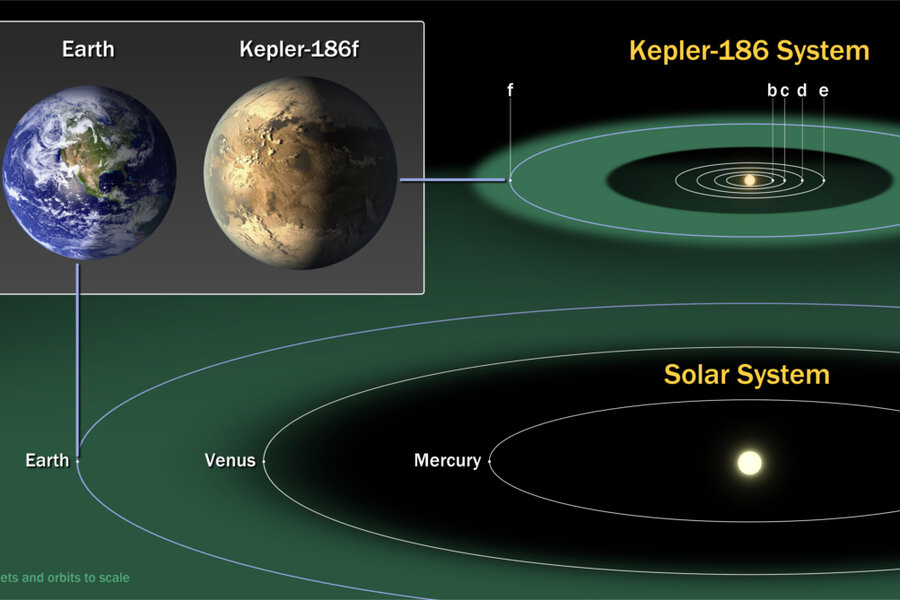Earth-sized planet discovered: Is our galaxy teeming with habitable worlds?
Loading...
For the first time, astronomers have confirmed the presence of an Earth-sized planet orbiting another star in its "habitable zone" – the not-too-hot, not-too-cold region where a star warms a planet just enough to allow liquid water to form lakes or oceans. The planet, known as Kepler-186f, shares its star with four similar-sized planets that are all much closer to their sun and thus are too hot for liquid water on the surface.
The star at the center of this small solar system, Kepler-186, is very different from our own star.
"Kepler-186 is an M dwarf, that is, smaller and cooler than our sun," says Elisa Quintana, lead scientist on a paper published in this week's Science.
M dwarfs are good targets in the search for habitable worlds, says Dr. Quintana, a research scientist at NASA's SETI Institute. Their relatively low temperatures mean that their habitable zones are small, so any life-friendly planets would need to be close. In fact, Kepler-186f is as close to its star as Mercury is to our sun.
When it comes to finding exoplanets – planets orbiting stars other than our own – small orbits are ideal.
"The Kepler mission uses the transit technique to find exoplanets," explains Douglas Hudgins, NASA's exoplanet exploration program scientist. "It's designed to measure the tiny dimming of a star that occurs when a planet's orbit causes it to pass in front of, or 'transit,' that star."
Smaller orbits make for more transits in a shorter window of time, notes Tom Barclay, a co-author on the paper. "Kepler 186f goes around its star every 130 days. Earth goes around its star every 365 days. So in the four-year duration of the Kepler mission, we could see more transits of Kepler-186f."
Watching for transits is a bit like looking for bugs at night by watching your neighbor's porch lights. Every dark streak against the glowing orange light bulb tells you there's an insect flying past. Big bugs are easier to spot than small ones, and insects staying close to the light are easier to see than those further away.
NASA's search for planets multiplies that theoretical porch-light survey on a massive scale. The Kepler Space Telescope has been watching about 160,000 stars near the constellations Cygnus and Lyra for the past five years. Kepler measures the amount of light coming from the stars, and astronomers watch for that light to be dimmed by a passing planet. Every measured decrease in the star's light represents a potential exoplanet, which must be verified by repeating the measurement again and again on subsequent orbits.
"To date, analysis of the data from just the first three years of those observations has revealed more than 3,800 exoplanet candidates," says Dr. Hudgins, "and more than 950 of those have subsequently been validated as actual planets and not false-positive signals."
The quicker the orbit, the easier an exoplanet is to observe and verify. The four inner planets of the Kepler-186 solar system, with orbits of 4, 7, 13, and 22 days respectively, were all spotted and confirmed within Kepler's first two years. This fifth planet, in the habitable zone, was far enough away that it took a third year of measurements to find it and a fourth year to confirm it, says Hudgins. All the measurements were gathered between May 2009, when Kepler was first launched, and May 2013.
Finding an Earth-sized planet near an M dwarf is actually easier than finding one near a star like our own, says Dr. Barclay, a research scientist at the Bay Area Environmental Research Institute at NASA Ames. "M dwarfs are great targets to search for habitable worlds," he says.
"M dwarfs ... range in size from about 10 percent of the size of the sun to about half the size of the sun. Kepler-186 here is on the larger end of the scale, being about half the size of the Sun. The size difference helps us find planets," he explains. "The larger the star, the shallower the transit, because what we measure is the ratio between the size of the planet and the size of the star. So you shrink the star and you get a deeper transit. Deeper transits are easier to detect, so we find it easier to detect smaller planets around these smaller stars."
Plus, M dwarfs are incredibly common. "They're the most abundant stars in our galaxy," says Barclay. "There are 100 billion stars in our galaxy, and 7 out of every 10 of them are M dwarfs. This means that most Earth-type planets in their habitable zones will be around M dwarfs, simply because most stars are M dwarfs. They're also our nearest neighbors. Most of the nearest-by stars to us are M dwarfs. Now when you go out to your backyard and look at the sky, you won't see any M dwarfs. They're very faint – you can't see any of them with the naked eye – however they are there."
M dwarfs are also known as red dwarfs, because they emit more light in the red and infrared spectrum than our sun, which emits most of its light in the visible spectrum. Kepler-186 emits only about a third as much light as our sun.
If there is life on Kepler-186f, it will have adapted to this different amount and color of sunlight, notes Victoria Meadows, principal investigator for the Virtual Planetary Laboratory.
"It's fun to note that if the planet is habitable, photosynthesis may be possible," she says. On Earth, "we have shade plants that live under the canopy of rainforests and so forth that routinely manage to photosynthesize even in those sorts of light levels."
Of course, there is no evidence yet that Kepler-186f has life of any kind, let alone photosynthesis. All that is certain so far is that the planet is in the right place to make liquid water possible on its surface: "This is the first validated, Earth-sized planet in the habitable zone of another star," says SETI Institute's Quintana. "We can now say that other potentially habitable worlds, similar in size to our Earth, can exist. It's no longer in the realm of science fiction."








